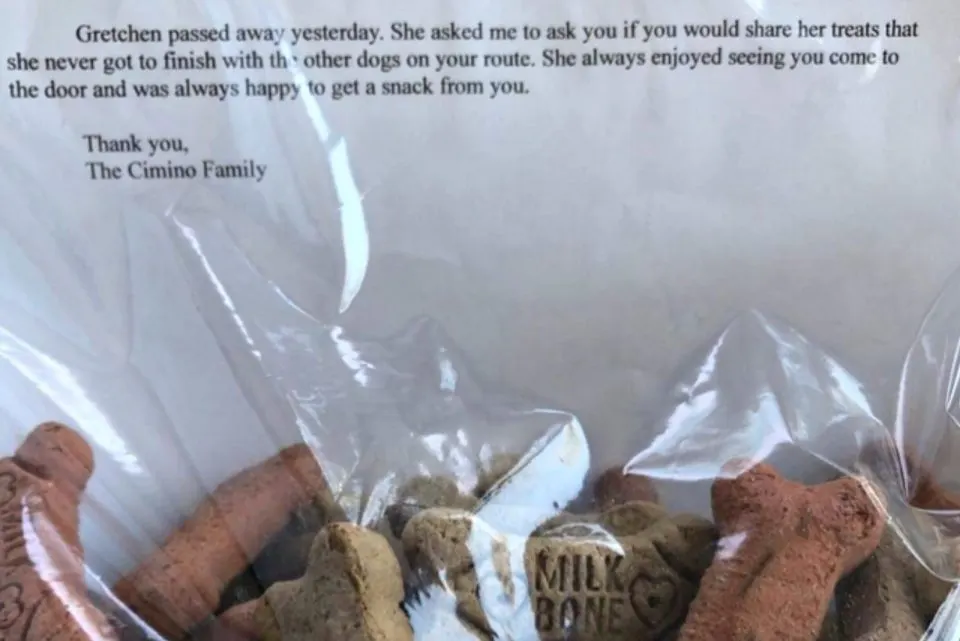Who said mailmen and dogs can’t be friends?
That’s a myth!
I’ve seen plenty of dog & mailmen friendships, and I can proudly say they’re just as good of friends as anyone else. Dogs don’t discriminate. They don’t just hate a person for wearing a uniform.
Dogs sense who’s good and who’s bad.
One mailman is apparently a hella good person because all the dogs on his route love him! Some don’t stop loving even after they cross the rainbow bridge.
Gretchen, a German Shepherd from the street he works on, left her mailman and made everyone tear up.
Warning: Waterworks coming!
A Special Note For Her Favorite Mailman
Fernando has been a mailman for years, performing his duties with utmost care. He loves his job and his route. But, it’s not only bringing mail to people that makes him happy. It’s the fact that his route is packed with happy doggos all eager to see him every day.
Fernando’s story went viral because of something his daughter posted on Twitter. She said her dad always carried along a bag of milky bones to hand them out to his canine neighbours. They all loved him for this sweet act of kindness.
But, one message stood out. A user listed as @amorningsting posted a screenshot of her father’s text saying one of his doggy buddies, a GSD girl named Gretchen, passed away and left him a message.
“Aww… just found out one of my buddies passed away yesterday… Gretchen was a huge German Shepherd, but she was a Teddy bear,” said Fernando in his text.
The special message to Fernando left space for waterworks to enter the scene.

But, the story doesn’t end here.
Since the tweet went viral, a lot of people saw it, including Gretchen’s owner who replied:
“My wife and I were told about Gretchen’s letter to Fernando being on Twitter. I can’t begin to tell y’all how much it has meant to us seeing how much love and support y’all have shown our girl. She was the absolute best.”

Gretchen was the sweetest girl, adopted by the Cimino family from the shelter when she was just two years old. She will be missed not just by her family, but by her dear mailman, Fernando.
See, I told you that dogs and mailmen can be friends!
If you find yourself wondering why your furry companion seems to be constantly vocalizing with whines, you’re not alone. As a seasoned dog trainer, I’ve encountered this behavior in many canine friends. Understanding the reasons behind your dog’s persistent whining can be a key step in strengthening your bond and improving their overall well-being.
Picture this: you’re relaxing at home, and all you hear is your dog’s continuous whining. It can be both puzzling and concerning. But fret not, as there are various factors that may contribute to this behavior. By delving into the possible causes, you’ll be better equipped to address your dog’s needs and create a harmonious environment for both of you.
Understanding Canine Whining Behavior
The Basics of Dog Communication
Dogs communicate through various vocalizations, and whining is one of the ways they express themselves. It’s essential to recognize that whining is your dog’s way of trying to convey a message to you. Understanding the basics of dog communication can help you interpret what your furry friend is trying to express.
Common Triggers for Whining
Several common triggers can lead to your dog whining. These triggers can include hunger, discomfort, anxiety, attention-seeking behavior, or even a medical issue. By identifying these triggers, you can address your dog’s needs accordingly and create a more comfortable and harmonious environment for both you and your beloved pet.
Health-Related Reasons for Whining
Pain and Discomfort
If your dog is whining excessively, it could be a sign of pain or discomfort. Dogs can’t verbally express when they’re hurting, so whining is their way of signaling distress. Common causes of pain include arthritis, dental issues, or injuries. Make sure to observe your dog’s behavior for any signs of discomfort and consult your vet for a proper diagnosis.
Anxiety and Stress
Anxiety and stress can also lead to constant whining in dogs. Changes in their environment, separation anxiety, or loud noises can trigger anxious behavior. If your dog is whining persistently, it might be due to feeling stressed. Creating a calm and safe space for your pet, using comforting techniques, or even seeking professional help can help alleviate their anxiety and reduce excessive whining.
Behavioral Causes of Whining
When it comes to your dog’s incessant whining, there are a few behavioral causes you may want to consider. Understanding why your furry friend is constantly vocalizing can help you address the issue more effectively.
Attention-Seeking Behavior
Dogs are social animals and crave attention from their humans. If your dog feels neglected or wants your focus, they may resort to whining as a way to seek your attention. This behavior can be common, especially if your dog feels lonely or left out.
To address attention-seeking whining, ensure that you’re providing your dog with enough quality time, play, and exercise. Engaging in interactive activities and training sessions can help fulfill your dog’s need for attention, reducing their whining behavior.
Boredom or Lack of Stimulation
Dogs need mental and physical stimulation to stay happy and content. If your dog is bored or lacks proper stimulation, they may whine out of frustration or restlessness. This type of whining is their way of signaling that they need more activity and engagement in their daily routine.
To combat whining due to boredom, make sure to include regular playtime, walks, and interactive toys in your dog’s schedule. Providing challenging toys, puzzle feeders, or engaging in new activities can help keep your dog mentally stimulated and curb excessive whining.
Environmental Factors
Changes in the Household
When your dog whines more than usual, consider any recent changes in your home environment. Dogs can be sensitive to alterations in their surroundings, such as moving to a new house, rearranging furniture, or welcoming a new family member. These changes may disrupt your dog’s sense of security, causing them to whine as a form of expressing their discomfort. Providing reassurance, maintaining a consistent routine, and offering extra love and attention can help your pet adjust to these changes and reduce excessive whining.
Inadequate Training or Socialization
Inadequate training or socialization can contribute to persistent whining in dogs. If your furry friend was not properly trained or lacks exposure to different people, animals, or environments, they may display anxious behaviors like whining. Training classes, socialization outings, and positive reinforcement techniques can help build your dog’s confidence and reduce whining caused by insecurity or fear. Investing time and effort in training and socialization can significantly improve your dog’s behavior and address excessive whining issues effectively.
How to Respond to Your Dog’s Whining
Properly Interpreting the Whines
When your dog whines, it’s essential to understand what they might be trying to communicate. Here are a few common reasons your dog may be whining:
- Attention: Your dog might whine to seek attention from you.
- Discomfort: Whining could indicate that your dog is in some discomfort.
- Anxiety: Dogs may whine when they feel anxious or stressed.
- Hunger: Your dog might be hungry and trying to let you know.
- Loneliness: Whining could be a sign of loneliness or separation anxiety.
- Health Issues: Whining can also be a symptom of underlying health problems.
By recognizing these signals, you can better understand your pet’s needs and respond accordingly.
Tips for Reducing Excessive Whining
Here are some practical tips to help decrease your dog’s whining behavior:
- Provide reassurance: Comfort and reassure your dog to help alleviate anxiety or stress.
- Maintain routines: Consistency in feeding, walks, and playtime can reduce whining caused by uncertainty.
- Training and socialization: Invest time in training and socializing your dog to build confidence and ease any behavioral issues.
Remember, understanding the reasons behind your dog’s whining and implementing appropriate responses can strengthen your bond and create a more peaceful environment for both you and your furry companion.
Conclusion
Understanding why your dog whines all the time is key to addressing their needs effectively. From seeking attention to signaling discomfort or anxiety, your furry friend communicates in various ways. By recognizing these signals and taking appropriate actions, such as providing reassurance and maintaining routines, you can create a harmonious environment for both of you. Remember, building a strong bond with your dog involves listening to their needs and responding with care. With patience, consistency, and love, you can help your dog feel more secure and content, leading to a happier and healthier relationship.
Frequently Asked Questions
Why do dogs whine?
Dogs whine to communicate various needs or emotions such as hunger, discomfort, anxiety, seeking attention, or health issues.
What triggers a dog to whine?
Factors like loneliness, boredom, lack of stimulation, and anxiety can trigger a dog to whine excessively.
How can I interpret my dog’s whines?
Understanding your dog’s whines involves recognizing signals for seeking attention, discomfort, anxiety, hunger, loneliness, or health concerns.
What can I do to reduce my dog’s whining?
To reduce excessive whining, provide reassurance, stick to routines, invest in training, and foster socialization for increased confidence.
[no_toc]

Hey there, I’m Janet Brooks, a dog-loving student from California. I’m all about helping pups in need, especially those without homes. Me and my awesome friends work together to give shelter and love to stray dogs. Oh, and I also write blogs about dogs to share helpful info.